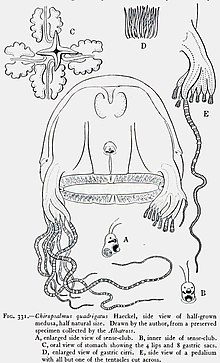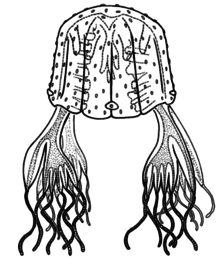Chiropsalmus quadrumanus, commonly known as the four-handed box jellyfish, is a species of box jellyfish found in the western Atlantic Ocean, the Gulf of Mexico and the Pacific Ocean. The sting is venomous and dangerous to humans, especially children.
| Chiropsalmus quadrumanus | |
|---|---|

| |
| Chiropsalmus quadrigatus, side view of half-grown medusa. Drawn from a preserved specimen. A, enlarged side view of sense-club. B, inner side of sense-club. C, oral view of stomach showing the 4 lips and 8 gastric sacs. D, enlarged view of gastric cirri. E, side view of a pedalium with all but one of the tentacles cut across. | |

| |
| Scientific classification | |
| Domain: | Eukaryota |
| Kingdom: | Animalia |
| Phylum: | Cnidaria |
| Class: | Cubozoa |
| Order: | Chirodropida |
| Family: | Chiropsalmidae |
| Genus: | Chiropsalmus |
| Species: | C. quadrumanus
|
| Binomial name | |
| Chiropsalmus quadrumanus | |
| Synonyms[1] | |
| |
Taxonomy
editLittle and/or poor taxonomic research has been conducted on Chiropsalmus quadrumanus. In 2006, Lisa-ann Gershwin noted that the South American neotype's cnidome was differing from the United States species. Several studies on the species have been conducted since then. One in 1975 gives statistics and charts that clearly shows the differing cnidomes of U.S. species compared to that of the neotype of Gershwin's. No new taxa have been erected to accommodate the research.[2]
Description
editChiropsalmus quadrumanus is a cube-shaped, colourless, transparent jellyfish with a diameter of about 14 centimetres (5.5 in) and height a little less than this. The body is composed of a gelatinous material and the top edges are rounded while the top surface is flat. Bundles of 7 to 9 tentacles dangle from pedalia, palmate appendages at the four lower corners of the bell, with a tentacle on each "finger". The outer two tentacles are pinkish and the inner ones yellowish white and they can be up to 3 to 4 metres (9.8 to 13.1 ft) long. Halfway up the inside of the bell is the velarium, a horizontal ring of tissue partially blocking the aperture. The manubrium is a central column hanging down inside the bell with the mouth at its tip. The rounded stomach has four pouches connecting to radial sinuses along the edges of the bell. The gonads are on either side of the radial canals.[3]
Distribution and habitat
editChiropsalmus quadrumanus is found on the east coast of North America in North and South Carolina, Georgia, Florida, Alabama, Mississippi, Louisiana, Texas, the Caribbean, the Gulf of Mexico and Mexico, and a disjunct population in Brazil.[4] It also occurs in the Pacific Ocean and has been reported from Hawaii and Australia. It is usually found in the warm, open seas but it is sometimes found inshore in large numbers in places where it has not been previously found. When this happened on the Texas Gulf coast in 1955 and 1956, it coincided with drought conditions and an associated high salinity level in the area. The jellyfish were seldom seen near the surface but small specimens were frequently taken in shrimp trawls. After gales large quantities were washed up on the beach, and after heavy rains, many dead jellyfish were found floating on the surface. When conditions returned to normal, the jellyfish disappeared.[5]
Toxicity
editThe long tentacles of Chiropsalmus quadrumanus are armed with nematocysts, the purpose of which is to capture prey such as small fish and to deter predators. They can inflict an extremely painful sting on people that encounter them. There is a documented case of a four-year-old boy in the Gulf of Mexico dying within forty minutes of being stung.[6][7] Of forty-nine people stung by jellyfish off the coast of Brazil over a five-year period, twenty were by identifiable species. Sixteen of these were identified as being caused by Chiropsalmus quadrumanus and four by the Portuguese man o' war (Physalia physalis). All these stings were linear in nature, causing both intense pain and systemic symptoms.[8] Apart from pain, the symptoms include cardiac dysfunction and respiratory depression. The rash lasts for several months. Antivenom administered within a few hours relieves the pain somewhat, reduces the severity of the rash, and improves other symptoms. In extreme cases, cardiopulmonary resuscitation can be effective if started promptly.[9]
References
edit- ^ a b Collins, Allen G. (2010). "Chiropsalmus quadrumanus (F. Muller, 1859)". WoRMS. World Register of Marine Species. Retrieved 2012-06-20.
- ^ Calder, Dale R. (January 2009). "Calder, D.R. 2009. Cubozoan and scyphozoan jellyfishes of the Carolinian biogeographic province, southeastern USA. Royal Ontario Museum Contributions in Science 3: 1-58". Retrieved 5 March 2019 – via www.academia.edu.
{{cite journal}}: Cite journal requires|journal=(help) - ^ Chiropsalmus quadrumanus Marine Species Identification Portal. Retrieved 2012-06-20.
- ^ Perry and Larsen (2004). "Chiropsalmus quadrumanus (F. Muller, 1859)" (PDF). Guide to Shelf Invertebrates, Gulf of Mexico. Archived from the original (PDF) on 2022-10-15. Retrieved 2012-06-05.
- ^ Guest, William C (1959). "The Occurrence of the Jellyfish Chiropsalmus Quadrumanus in Matagorda Bay, Texas". Bulletin of Marine Science. 9 (1): 79–83.
- ^ Bengston, K.; Nichols, M. M.; Schnadig, V.; Ellis, M. D. (1991). "Sudden death in a child following jellyfish envenomation by Chiropsalmus quadrumanus: Case report and autopsy findings". JAMA: The Journal of the American Medical Association. 266 (10): 1404–1406. doi:10.1001/jama.1991.03470100096040. PMID 1679136.
- ^ Fenner, P.J. "Venomous jellyfish of the world" (PDF). South Pacific Underwater Medicine Society Journal. 35 (3): 133. Archived from the original (PDF) on December 13, 2013. Retrieved 27 June 2012.
- ^ Vidal Haddad Jr.; Fábio Lang da Silveira; João Luiz Costa Cardoso; André Carrara Morandini (2002). "A report of 49 cases of cnidarian envenoming from southeastern Brazilian coastal waters". Toxicon. 40 (10): 1445–1450. CiteSeerX 10.1.1.621.8209. doi:10.1016/S0041-0101(02)00162-9. PMID 12368114.
- ^ "Venomous and Poisonous Animals Biology & Clinical Management". VAPAGuide. Retrieved 2012-06-22.